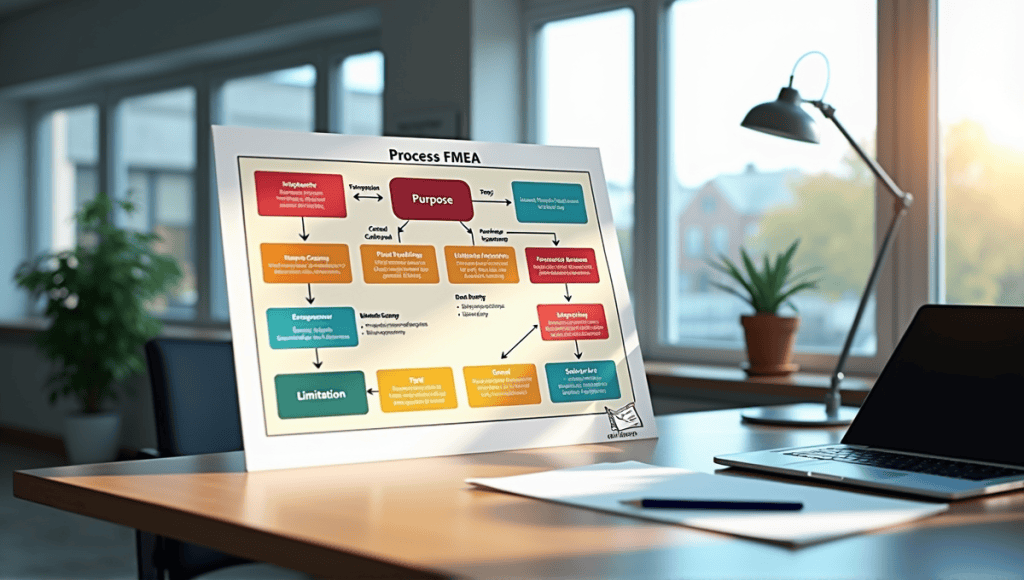FMEA is an excellent tool to identify potential failures in products, processes, or systems. As an expert with experience implementing FMEA analysis in various industries, I’ll show you the various types of FMEA. You’ll then know which FMEA to select based on whether you’re designing a new product, optimizing a process, or assessing a system. Let’s dive into the world of FMEA.
Overview of FMEA Types

The tool dates back to the 1940s, when the US military developed FMEA to assess equipment failures. Since then, FMEA has become a widely adopted tool across industries.
Here’s a brief overview of FMEA’s historical development:
- 1940s: The US military creates FMEA for reliability analysis.
- 1960s: NASA begins using FMEA for aerospace applications.
- 1970s: The automotive industry starts using FMEA.
- 1980s: FMEA becomes popular in manufacturing.
- 1990s-Present: FMEA expands into healthcare, software, and other industries.
Selecting the right type of FMEA is critical. If you choose the wrong one, you’ll waste time and miss important insights. I’ve witnessed teams struggle because they used a process FMEA to solve a design issue.
All types of FMEA contain these common steps:
- Identifying potential failure modes
- Evaluating severity, occurrence, and detection
- Calculating Risk Priority Numbers (RPN)
- Creating recommended actions
- Assessing the results and following up
Understanding these basics will allow you to effectively apply any type of FMEA. Let’s examine the specific types to determine which one is best for you.
Design FMEA (DFMEA)
Design FMEA is another tool to prevent design failures. You’ll conduct this analysis early in a product’s development to ensure it’s designed for reliability and safety.
I’ve facilitated many design FMEA sessions for new products. We typically start these when the design concept is complete and finalized before we start prototyping. This timing allows us to make cost-effective design changes.
The basic idea of design FMEA is to analyze:
- Product functions and requirements
- Potential failure modes of each function
- The impact of that failure
- The root cause of the failure
- Existing design controls
- Actions you can take to reduce risk
Design FMEA is useful because it helps you uncover design weaknesses early in the process. As a result, you’ll slash warranty costs and provide a better experience for your customers. However, design FMEA isn’t comprehensive, as it won’t uncover all manufacturing defects or potential issues the user might encounter.
For example, in a design FMEA for a new design of a car seat, we identified a failure in the reclining mechanism. We redesigned it, and this prevented potential injuries and a major product recall.
Design FMEA is your best friend when conducting product design improvements. Use this analysis to find problems before they find you.
Process FMEA (PFMEA)

I’ve performed PFMEA in manufacturing environments extensively, and it’s very helpful for optimizing production lines and reducing defects.
The main components of PFMEA include:
- Process steps and requirements
- Potential failure modes of each step
- Effects of each failure mode
- Causes of each failure mode
- Current process controls
- Recommended actions to mitigate the risk
PFMEA has many benefits. You’ll make the process more efficient and reduce waste. It also ensures that defective products don’t reach customers. The primary downside is that it won’t help you identify product design issues.
For example, a PFMEA analysis we did in a bottling plant revealed a risk of underfilled bottles due to worn pump seals. By implementing a schedule to proactively replace the pump seals, we were able to eliminate that issue.
PFMEA is critical to optimizing your processes. Use it to identify and resolve weak points in your production process or service delivery.
System FMEA (SFMEA)
System FMEA is designed to evaluate potential failures within a system or on a large scale project. You would use SFMEA when there are various interconnected components or processes.
I’ve applied SFMEA in a range of industries, from automotive to aerospace. It’s especially helpful when working on projects with many interdependencies.
The main elements of SFMEA are:
- System functions and interfaces
- Potential failure modes at the system level
- The impact of each failure mode on the overall system
- The causes of each failure mode
- System-level controls currently in place
- Recommended actions to mitigate system-level risks
SFMEA helps you take a high-level view of potential failures. You’ll also catch risks that might not otherwise show up in a component-level analysis. The only downside is that it’s challenging to manage the complexity of properly conducting system FMEAs.
For example, we once completed an SFMEA of a new automated warehouse system. During the analysis, we discovered a potential failure related to how the picking robots communicated with the inventory software. By catching this early, we saved ourselves from a set of headaches once the warehouse was up and running.
SFMEA is your solution if you’re working on a more complex project. Use it to verify all system components work together without fail.
Comparison of FMEA Types
It’s important to know when to use each FMEA type. Use this simple FMEA comparison table to select the appropriate one:
| Factor | DFMEA | PFMEA | SFMEA |
|---|---|---|---|
| Focus | Product design | Manufacturing/service process | Complex systems |
| Timing | Early design phase | Process planning/improvement | System design/integration |
| Scope | Individual components | Process steps | System-level interactions |
| Team | Design engineers | Process engineers, operators | Cross-functional experts |
Choose the FMEA type that best fits your specific situation.
- If you have a product design issue, use DFMEA.
- If you’re trying to optimize a process, use PFMEA.
- If you have an issue with a complex system, use SFMEA.
These FMEA types are often interconnected.
- For example, a design change from a DFMEA might require an update to a PFMEA.
- Findings from an SFMEA might lead to both design and process changes.
I’ve found the best results by using multiple FMEA types in conjunction. This approach ensures you consider potential failures at each level.
Advanced FMEA Types

- Software FMEA (SWFMEA):
- Focuses on identifying potential software system failures
- Analyzes code, interfaces, and user experience failures
- Essential for any mission-critical software application
- Concept FMEA:
- Used in the earliest stages of product development
- Identifies potential failures in the product concept
- Helps decide between competing design concepts
- Functional FMEA:
- Identifies failures based on the product’s function
- Bridging the gap between a concept and a detailed design
- Particularly valuable in more complex products with multiple functions
Each of these advanced FMEA types allows you to analyze an even more specific failure mode. I’ve personally used SWFMEA in automotive electronic projects, and it was extremely effective at helping our team uncover and prevent software failures that could impact the safety of the vehicle.
If you have a very specific challenge, consider using one of these specialized FMEA types. You’ll likely uncover insights that you wouldn’t have found using a traditional FMEA.
FMEA Implementation Process
Applying FMEA effectively requires a systematic approach. Here are the seven steps to FMEA I follow:
- Define the scope and boundaries
- Gather a cross-functional team
- Identify potential failure modes
- Determine the effects of each failure
- Identify the causes of each failure
- Assess current controls
- Develop and execute action plans
Each step demands thoughtful execution. For example, to select a team in step 2, ensure you have access to the necessary expertise. In step 3, use effective brainstorming to identify all potential failures.
The most common hurdle you’ll face is likely resistance to change and lack of action post FMEA. To overcome this, sell the benefits of FMEA and ensure clear accountability for action items.
Finally, remember FMEA is a living document. Revisit your FMEA and challenge it frequently as designs or processes change. By taking this continuous improvement approach, you’ll extract the most value from FMEA.
In Summary
Knowing the different FMEA types is key to managing risk effectively. I’ve witnessed many projects that have been successful due to proper FMEA. Just keep in mind that you’re not just finding risks; you’re preventing risks from occurring. Use the right FMEA type for your situation. Each FMEA (design, process, system) has its own advantages. Accept FMEA as one of the tools in your continuous improvement arsenal. It’s a skill you’ll use again and again in your career.






